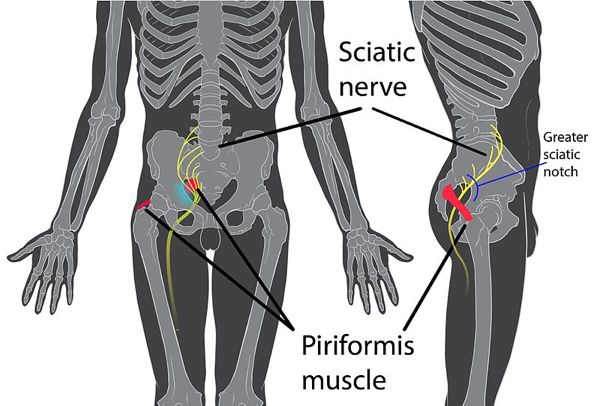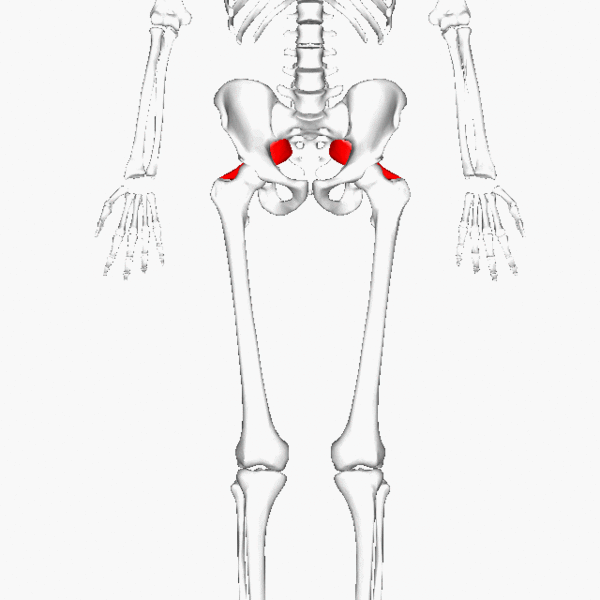Has writing become a literal pain in the butt?
Answer the following questions: Do you experience…
- Pain in the buttock muscle on just one side that radiates down the back of your leg?
- Numbness and tingling along the back of the leg?
- Sciatic pain?
- Pain that gets worse the longer you sit?
- Pain that causes you to sit more heavily on one side of your backside so you can relieve pressure on the other?
If you answered “yes” to any of these, you may be suffering from piriformis syndrome (PS). This is a condition that affects about 5 million Americans, particularly those who are runners and those who sit for hours a day. If you’re a runner and you sit for hours a day at the computer, you’re even more at risk.
PS is also responsible for about 5 percent of cases of sciatica, and affects women much more often than men, at a ratio of 6 to 1.
Here’s more on this literal pain in the butt and what you can do to help yourself feel better.
What is Piriformis Syndrome?
The piriformis muscles are small muscles that connect the base of the spine at the inside top of the buttocks with the outer tip of each thighbone. We all have two of them, one on each side, deep in the buttock area.

These little muscles help rotate the hip when standing, walking, and shifting our weight. They also help to maintain balance. Running diagonally from the spine to the thighbone, they share space with the sciatic nerve, which goes along underneath, though in some people the sciatic nerve actually runs right through the piriformis muscle.
Piriformis syndrome occurs when the muscle itself goes into spasm, or when it tightens and presses against the sciatic nerve, causing pain. Symptoms include the following:
- lower back pain
- pain in one side of the buttocks
- pain that radiates down the leg
- numbness and tingling in the back of the leg or buttock
- sciatica pain
- “electric shock” like pain running down the back of the leg
- pain that gets worse with climbing stairs or sitting for extended periods of time
Though PS and sciatica can both result in radiating pain down the back of the leg, different things cause the two conditions. Whereas PS causes sciatic pain when the muscle presses on the nerve, traditional sciatica is caused by a spinal problem, often stenosis or herniated discs.
You can usually tell if it’s PS that’s causing the problem by pressing on the area of the muscle to see if you feel pain or discomfort. You can also do some of the stretches below and see if they hit the source of your pain. Of course, your doctor can use a series of diagnostic tests to zero in on the problem, as well.
What Causes Piriformis Syndrome in Writers?
Overwork of the muscle is usually what causes the problem, which is why runners are at risk. There are a number of other risk factors as well:
- hip joint dysfunction
- weakness in the hip stability muscles
- overpronating feet
- feet with high arches
- age—PS is more common in those 40 and over
Women are also more at risk, scientists believe because of the different body shape. A woman’s pelvis is wider, to accommodate childbirth, and the quadriceps muscle angle at the hip is also wider. These two together can put more strain on the piriformis muscles.
At the core of the issue for most writers, however, is all that sitting. Not only does the extensive inaction weaken all of the muscles in your backside, back, hips, and legs, but it can put unhealthy pressure on the piriformis muscle.

Particularly if you sit with one foot underneath you, or with your legs wide (which externally rotates your hips—the piriformis muscles must work to keep them that way), you increase the pressure on these muscles, overworking them.
Slouching makes the problem worse, as it strains the lower back and tightens the muscles in your hips, further damaging the piriformis muscles.
Some Tests to Determine if You Have PS
If you want to know more before seeing the doctor, there are a few self-tests you can perform to see if your pain is coming from PS.
- Lie on a bed and allow your outside leg to rotate externally so your knee hangs off the surface. Now try to raise and lower the knee, and note any pain you feel. Those with PS will have difficulty with this exercise.
- Lie on your back and try to raise one leg straight up. If you feel pain shooting down the back of your leg, it’s likely due to irritation of the sciatic nerve, which may be caused by a spinal problem or by PS.
- Sit down in a chair and loosely tie a rope around your legs at the knee level. Allow some space between the knees. Once the rope is tied, press your knees outward, as if trying to break the rope. If this causes pain, again, you may have PS.
- Lie on your side, with the bottom leg straight, and the top leg bent at the knee. Rest the knee on the floor, then press your palm on the top of that knee. Try to raise the knee while simultaneously pressing down on it (for resistance) with your hand. Note any pain that you feel.
Though all these tests can help you determine if your piriformis muscle is inflamed, you can pass all these tests and still have PS. The main thing to watch for is that pain in the area where the muscle is, that gets worse when sitting.
How to Treat and Prevent PS
If you found that you do have pain that seems associated with PS, or if you just want to prevent it (always a good idea!), check with your doctor, and then get into the habit of performing the following stretches on a daily basis. They will help keep that muscle loose and flexible so it’s less likely to tighten and spasm, or to press on the sciatic nerve.
First, some general recommendations. If you’re already experiencing PS, realize that there’s no quick fix. It’s going to take time for that muscle to heal.
In the meantime, do the stretches below, and work on standing more often when you write. Try to avoid sitting for longer than 15 minutes at a time. Get up more often to walk around, and alternate more frequently between standing and sitting while working.
Stretch #1: Foam Roll Massage
Use a foam roll, or roll up a towel into a Tootsie-Roll shape. Place the roll under the fatty area above your sitting bones—those two bones at the lowest part of the backside. If you’re experiencing PS, you’ll feel when the roll is in the right place, about halfway between the base of your spine and the bottom of your seat.
Now, bracing yourself with one hand, cross one foot onto the opposite knee, and slowly roll the back of the hip, massaging that piriformis muscle.
Find a video on how to do this massage here.
Stretch #2: Yoga Pigeon Pose
If you know yoga, you already know this one. If not, don’t worry, it’s easy. Start on your hands and knees, then simply bend one leg and bring it forward, rotate the knee outward, and place your ankle on the floor. Extend the other leg back behind you.
Depending on your flexibility, you may be able to keep your bent leg at a 90-degree angle, or you may need to narrow that angle a bit by bringing your foot back in closer to you.
Find some instructions on how to do this one in the following video:
Stretch #3: Bent-Leg Stretch
Lie on your back, bend one leg and bring the knee in toward your chest. Bend your other leg slightly, and place the ankle of the first leg on the knee of the second leg. Reach your arms under the second leg and pull it toward you.
Your first leg should now be bent at a right angle, your knee out, and you should feel the stretch in your piriformis area as you pull the other leg toward you.
Hold for 30 seconds to a minute, release, and repeat. Here’s a video to help you learn how to do this one:
You can also do this one while sitting, as demonstrated here. Once you have your knee crossed over, keeping your back straight, lean forward a little until you can feel the stretch.
Make Lifestyle Changes that Accommodate Your Work and Your Body
The best way to approach this sort of pain is like any other associated with the writing profession—incorporate new habits into your daily life that help you take care of your body. In this case, get up more often, and get used to stretching this muscle on a regular basis.
Have you experienced this type of pain? How did you relieve it?
Images
(piriformis muscles diagram) By Patrick J. Lynch & KDS4444, via Wikimedia Commons
(rotating piriformis) By BodyParts3D/Anatomography, via Wikimedia Commons
Sources
Andrew Walker, “Piriformis Syndrome…a Real Pain in the Butt?” PhysioWorks, https://physioworkshsv.com/piriformis-syndrome-a-real-pain-in-the-butt/.
John Davis, “Piriformis Syndrome: How to detect it and strengthening and stretching programs to help you heal,” RunnersConnect, https://runnersconnect.net/piriformis-syndrome-running/.


Oh, do I ever know this one, Colleen! I have hip dysplasia so boy, do I get a lot of this. And these stretches help! Two years ago, I started a fabulous program called Classical Stretch. It’s changed my life. And the #2 and #3 here are ones we do. I can vouch these work!
Ugh, sounds painful, Susan. Glad these help. I do them daily, too. Thanks for the rec on “Classical Stretch.”
Super helpful, Colleen. Thanks.
So glad, Jo-Anne. :O)
I use Stretch #3 daily along with a couple more stretches to relieve the tightness in those muscles. A few years ago, I learned a routine from an Egoscue therapist that helped a lot, but then I got too lazy about the daily exercises and am having to start all over. A good reference is the Pain Free book by Pete Egoscue — the therapy sessions at an Egoscue clinic are even better, but it’s kind of pricey and not usually covered by insurance.
Thanks for the tips, Pat! :O)